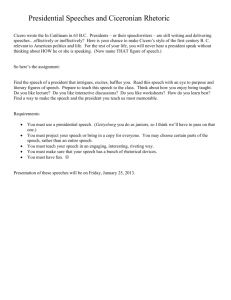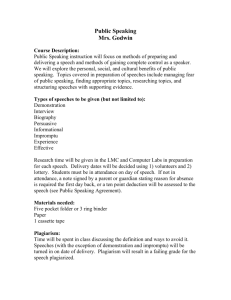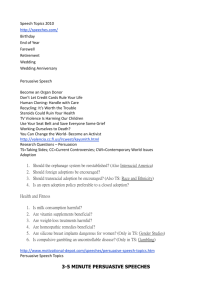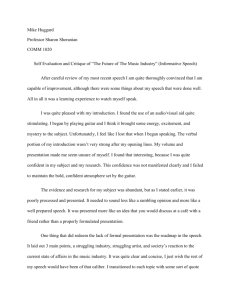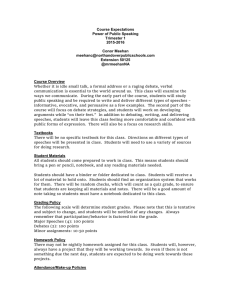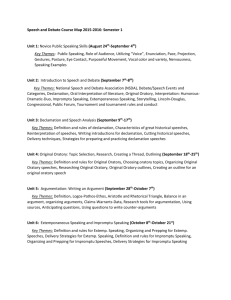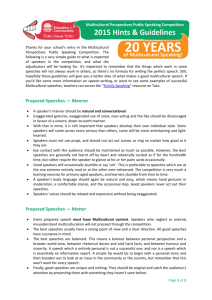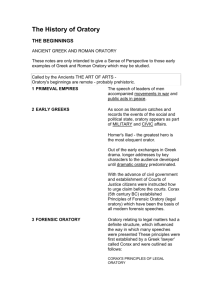What is Oratory/Public Speaking? Public Speaking or oratory is the
advertisement
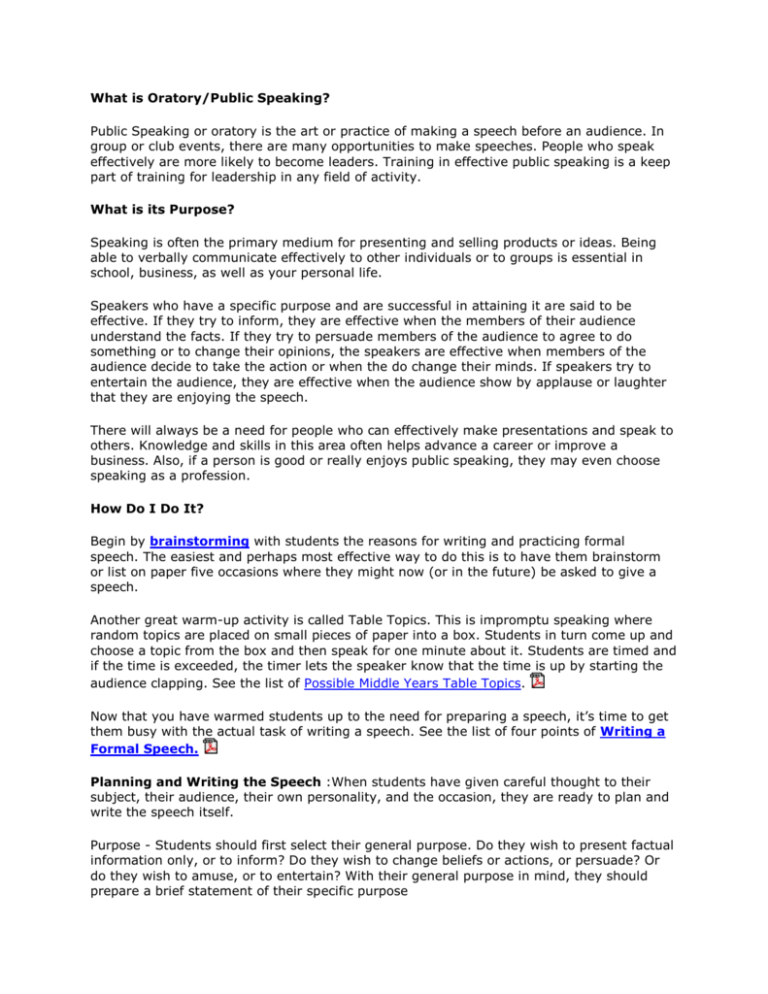
What is Oratory/Public Speaking? Public Speaking or oratory is the art or practice of making a speech before an audience. In group or club events, there are many opportunities to make speeches. People who speak effectively are more likely to become leaders. Training in effective public speaking is a keep part of training for leadership in any field of activity. What is its Purpose? Speaking is often the primary medium for presenting and selling products or ideas. Being able to verbally communicate effectively to other individuals or to groups is essential in school, business, as well as your personal life. Speakers who have a specific purpose and are successful in attaining it are said to be effective. If they try to inform, they are effective when the members of their audience understand the facts. If they try to persuade members of the audience to agree to do something or to change their opinions, the speakers are effective when members of the audience decide to take the action or when the do change their minds. If speakers try to entertain the audience, they are effective when the audience show by applause or laughter that they are enjoying the speech. There will always be a need for people who can effectively make presentations and speak to others. Knowledge and skills in this area often helps advance a career or improve a business. Also, if a person is good or really enjoys public speaking, they may even choose speaking as a profession. How Do I Do It? Begin by brainstorming with students the reasons for writing and practicing formal speech. The easiest and perhaps most effective way to do this is to have them brainstorm or list on paper five occasions where they might now (or in the future) be asked to give a speech. Another great warm-up activity is called Table Topics. This is impromptu speaking where random topics are placed on small pieces of paper into a box. Students in turn come up and choose a topic from the box and then speak for one minute about it. Students are timed and if the time is exceeded, the timer lets the speaker know that the time is up by starting the audience clapping. See the list of Possible Middle Years Table Topics. Now that you have warmed students up to the need for preparing a speech, it’s time to get them busy with the actual task of writing a speech. See the list of four points of Writing a Formal Speech. Planning and Writing the Speech :When students have given careful thought to their subject, their audience, their own personality, and the occasion, they are ready to plan and write the speech itself. Purpose - Students should first select their general purpose. Do they wish to present factual information only, or to inform? Do they wish to change beliefs or actions, or persuade? Or do they wish to amuse, or to entertain? With their general purpose in mind, they should prepare a brief statement of their specific purpose The main ideas - The next step should be to select the main ideas, or main divisions, of the subject as stated in the specific purpose. In informative speeches, the main ideas should define the specific purpose by answering the questions who? what? where? when? why? and how? In persuasive speeches, the main ideas ought to be the principal reasons for the desired belief or action. In entertaining speeches, the main ideas should be the divisions of the subject that can be amusing to the audience. Supporting material - After selecting the main ideas, they should choose supporting material. This includes such things as description, narration, comparisons, examples, testimony, statistics, visual aids (charts, diagrams, demonstrations, slides, maps, motion pictures, photographs, samples, or working models), and repetition (restatement of important ideas to increase the chance that they will be remembered). The selection of main ideas and supporting material completes the body (main part) of the speech. Introduction - Students should next plan the introduction. This usually has two parts, the opening and the statement of the specific purpose. In the opening, speakers catch the attention of their audience and arouse interest in their subject. They can do this by telling a joke or story, or by providing a fact or statistic. They may refer to an event, or to the present occasion, place, or audience (with humor or congratulations). They may quote something or ask a question. In their statement of specific purpose, they tell the audience precisely what they intend to do in their speech and what value this topic has for the audience. Conclusion - Next comes the preparation of a conclusion. In informative speeches, this part should be a summary of the main ideas and specific purpose. In persuasive speeches, the conclusion should combine a summary with a final appeal to the audience to accept the arguments offered. Entertaining speeches usually end on a point of great amusement, without any type of formal conclusion. Outline - After all these steps, the students should prepare an outline. An outline is simply a listing of the ideas to be elaborated upon in the order in which they will occur. Delivering the speech: Students may deliver their talks directly from the outline, or they may use the outline as the basis for a written speech. Skilled speakers usually prefer to speak from the outline, without writing the whole speech down. A speech that is delivered from an outline, without being memorized, is said to be delivered extempore, or extemporaneously. Extempore speeches should not be confused with impromptu speeches. These types of speeches are made without any previous preparation, often without notice. If students are properly prepared, they should feel at ease in front of an audience. They should relax and speak in a natural voice. They should stand erect, make eye contact with individuals in the audience, and speak loudly enough to be heard easily. In addition, speakers should vary the pitch and volume of their voice and their rate of speech to avoid being singsong or dull. How Can I Adapt It? Oratory is often considered to be a middle years activity. However, public speaking skills can and should be started at a much younger age level. For grades 3 to 6, consider storytelling as an adaptation. Students might choose an existing story to retell in their own words or they could tell as story that they have written. For Kindergarten to grade 2, the basic recitation of a small poem makes a great entrance and exposure to public speaking. To assist students in choosing their topic, brainstorming and webbing are excellent strategies. If you wish to channel or restrict the choice of topics – consider having students write a speech about an adventure they have experienced. Assessment and Evaluation Where evaluation of Oratory is desired, it should be divided into two parts: content and delivery. Evaluation Rubric for Middle Years Speeches (word doc) Evaluation Rubric for Storytelling (word doc) The emphasis should be on delivery as an effective delivery is the most important goal of the speech making or storytelling process. Formal evaluation for younger grades (i.e. Kindergarten to grade 3) is not recommended. Students might simply be acknowledged for their participation in the form of a certificate. Teacher Resources Sample Middle Years 3-Minute Speech - The Golden Opportunities of Youth Speech Writing Summarized – These three pages may be made into transparencies for use on an overhead projector Strategies to Succeed in Public Speaking Allyn & Bacon Public Speaking Website SpeechTips.com Further Reading How to Write and Deliver Effective Speeches by Judith A. McManus, Arco, (July, 2002) The Elements of Speechwriting and Public Speaking by Jeff Scott Cook, Longman, (September, 1996) How to Write and Give a Speech by Joan Detz, St. Martin's Press, (October, 1992) This is from http://olc.spsd.sk.ca/de/pd/instr/strats/oratory/index.html
